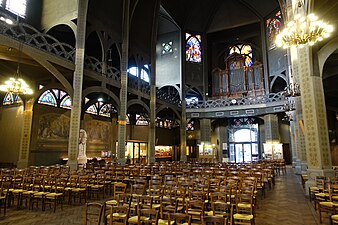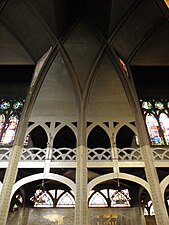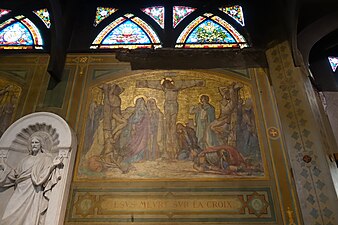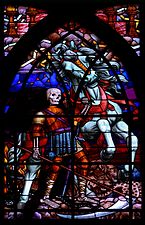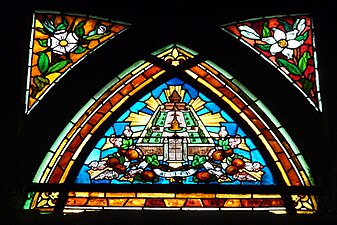Saint-Jean de Montmartre
| Church of Saint-Jean de Montmartre | |
|---|---|
Église Saint-Jean de Montmartre | |
Roman Catholic Church |
Saint-Jean de Montmartre (French pronunciation:
Situated at the foot of Montmartre, it was built from 1894 to 1904. It is notable as the first religious building in France built of reinforced concrete The brick and ceramic tile-faced structure exhibits features of Art Nouveau design while exploiting the superior structural qualities of concrete. The interior features a remarkable collection of Art Nouveau stained glass windows.[1]
The totality of the church was classified as an historic monument on 9 September 2014.[2]
History
The Church of Saint-Jean-Montmartre was the project of
Construction
The new church was designed by architect
This method used wire-reninforced, perforated brickwork as the permanent framework of a cement armature, together with thin, lightweight cement shells.[7] The strength provided by the reinforced concrete allowed the church to have thinner walls supporting vaulted ceilings. Previously, the heavy stone vaults had to be accompanied by thick walls that could handle the weight and thrust of the vault.[8][9]
Using reinforced concrete on Saint-Jean-de-Montmartre was ahead of its time and building codes had not caught up with the new technology. The building inspectors objected to a plan for twenty-five meter high columns that were only 50 centimeters in diameter, and outer walls only seven centimeters thick. Even some other architects opposed the plan, believing it would collapse. Construction was stopped as a result of a lawsuit filed in 1898 for " non-conformity of town planning".[10]
The construction halt was followed by an order for the demolition of completed portions of the building. To save the church, Baudot and Sobbeaux set up technical demonstrations, and made full-scale models of the columns in the garden of the church to demonstrate its strength and stability.This demonstration reassured the skeptics, the demolition order was lifted, and construction resumed. The church was finally consecrated in 1904.[11]
Exterior
-
Exterior
-
Ceramics and sculpture over the portal
-
An angel over the portal by Pierre Roche
The facade of the church is covered with red brick, which also provided additional support and helped insulate the interior. This gave the church the nickname "Saint-Jean-of-the Bricks".
Interior
-
The nave facing the altar, showing the lightweight steel framework.
-
The nave facing the portal
-
Vaults of the Nave
-
Grand arcades, tribunes and vaults
The arcades and tribunes in the interior are gray reinforced concrete and dimly lit. this darkness contrasts with the bright triangular stained glass windows along the nave, and the immense windows that fill the space over the choir.
The main altar in the choir is a particularly elaborate and colourful work, covered with mosaics by Guraud. It also displays a series of five medallions sculpted of bronze. These were made by Pierre Roche, and illstrate the attributes of the Evangelists; they include a bull, the attribute of Saint Luke, and a lion, the attribute of Saint Mark.[15]
-
The main altar in the choir
-
The Baptismal Font
-
"Mary, Consoler of the afflicted" by Eugene Thierry (1875-1961)
-
"Jesus dying on the Cross" by Eugene Thierry
The interior of the church, along the outer aisles, displays four mural paintings, the work of Eugene Thierry (1875-1961). These include "Christ dying on the Cross" and "Mary, Colsolatrice of the Afflicted".
Stained Glass
-
"The Crucifixion", the central window over the altar in the choir
-
"Christ multiplies loaves for distribution to the poor", by glass artist Jac Galland from a design by Pascall Blanchard.
-
"Christ saves an Adultress from Stoning" by Jac Galland and Pascal Blanchard
-
"The 4th Horseman of the Apocalypse" by Jac Galland
The church has a very fine collection of Art Nouveau stained glass. The central window over the altar is "The Crucifixion", by Léon Tournel, made in 1906. (Click image twice for full enlargement).
Two windows very vividly depicting two of the Four Horsemen of the Apocalypse. They are found in the Tribune, on either side of the grand organ.[16]
The nave displays another very elaborate and colourful set of four windows illustrating Christ performing miracles. halting a mob from stoning an adultress. These windows were made by glass designer Jac Galland, based on a drawing by Pascal Blanchard. [17]
-
"Litanies of the Virgin"
-
"Litanies of the Virgin - The Lamb
In addition to the larger and more elaborate windows, the sides of the nave are decorated with forty-eight colorful smaller triangular windows, illustrating the Litanies of the Virgin, and virtues associated with her.[18]
Organ
-
The piple organ located above the portal
The organ of Saint-Jean-de-Montmartre was originally built by Cavaillé-Coll in 1852 for a school, the École Sacré-Cœur de la Ferrandière in Lyon. It was moved and rebuilt in its new home in 1910 and enlarged in 1921, 1931 and 1934 by Gutschenritter. It was renovated in 1979 by Jacques Barbéris. The organ's condition started to deteriorate in 1986 and became practically unplayable by 2009. The City of Paris appointed the organbuilder Yves Fossaert to restore the instrument. This project, entirely financed by the City of Paris, began in 2009 and lasted fourteen months.
References
- ^ [1] Full article on church on patrimoine-histoire.fr (in French)
- ^ [2]|Designation as an historic monnument
- ISBN 978-1-936941-01-8.
- ISBN 0-674-83040-7.
- ISBN 978-1-86011-345-1. Retrieved 2013-06-01.
- ISBN 978-1-936941-01-8.
- ISBN 978-0-262-06173-5.
- ISBN 0-520-05586-1.
- ISBN 978-0-262-06173-5.
- ISBN 978-1-936941-01-8.
- ISBN 978-1-936941-01-8.
- ^ [3] Full article on church on patrimoine-histoire.fr (in French)
- ^ "Un Jour de Plus à Paris". Un jour de plus à Paris (in French). Retrieved 2018-11-22.
- ^ "Welcome to Travel France Online". Travel France Online. Retrieved 2018-11-22.
- ^ [4] Full article on church on patrimoine-histoire.fr (in French)
- ^ [5] Full article on church on patrimoine-histoire.fr (in French)
- ^ [6] Full article on church on patrimoine-histoire.fr (in French)
- ^ [7] Full article on church on patrimoine-histoire.fr (in French)
External links
- [8] Article on the church in the French Wikipedia (in French)
- [9] Full article on church on patrimoine-histoire.fr (in French)
- Photo Gallery
- To obtain the stoplist for this organ, as well as for all the organs of Paris
- Parish website
| Located near the Abbesses .
|





